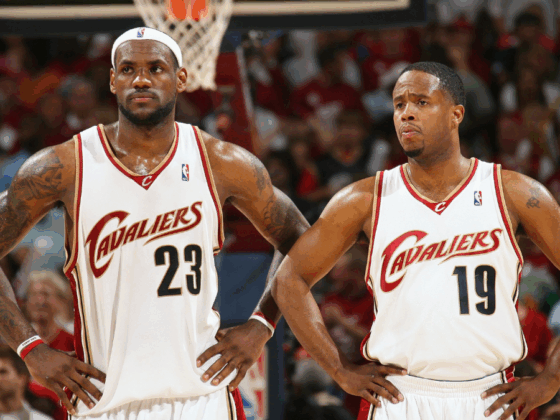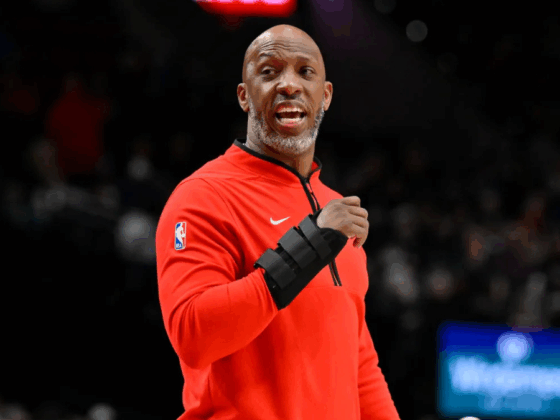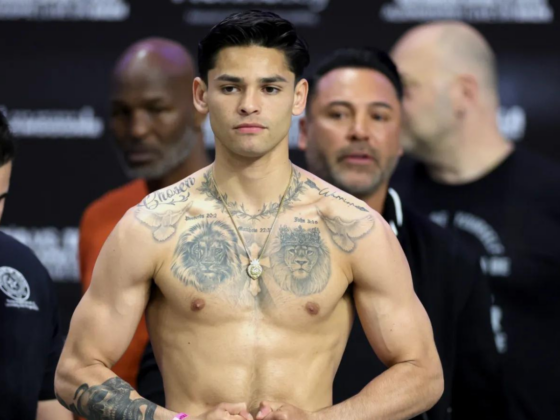
In Philadelphia, making the offense run fluidly through Joel Embiid, Jimmy Butler and Ben Simmons has been no easy task. The 76ers roster and its current scheme are both tailored to fit the games of Butler and Embiid, which means that they slow the ball down and run most of their offense from either the top of the key or the low post. Simmons at the top of the key works fine, but when he’s there he doesn’t do much more than feed Embiid on the block and hit shooters coming off screens which isn’t the best use of his talent. Now, they have experimented with using him in more of that Embiid role down in the post, but the results have not been great.
The problem with using Simmons in that role now is that he’s such a predictable scorer that smart defenses can put only one guy on him and shut down everything else for Philly. That’s what happened in the possession below where Simmons isolates on the block, looks for a few cutters only to realize that the defense stayed home before taking a few dribbles and hoisting up a bad shot:
He just doesn’t have a deep enough bag to be able to score in the half-court on a consistent basis. And that’s not really his fault; he’s a 22-year-old guard whose teams up to this point almost all ran at his pace. But it’s something that he needs to overcome. Even if he does end up leaving Philadelphia, gets his own team and runs like hell every possession, he still needs to be an effective scorer in the halfcourt. He doesn’t need to be LeBron James or Stephen Curry, but he needs to be a threat so he can keep playing his game.
When the defense shuts down the thing that Simmons wants to do, particularly in the post, he doesn’t have a backup plan. For him to take the next step as a playmaker, especially a primary one, he needs to have counters. He’s already shown some natural talent on the block, like in the play below where he takes his time, bullies Pascal Siakam and finishes with a nice reverse:
More often than not, however, the defense leaves one guy on him, stays home on shooters and Simmons can’t create well enough for himself to exploit a clear mismatch:
Even just a couple more go-to moves on the block could make him a way more credible threat with the ball in his hands and start opening up more opportunities. If defenses have to give him more respect as a scorer, then he can start using his vision more in the post and exploit the playmaking opportunities from there.
At this point, he has the credibility of a traditional center in the halfcourt as a scorer and that’s unacceptable for a point guard. After that initial action as a passer, he really doesn’t have the tools to do much more than cut to the hole and wait in the dunker’s spot. As I said in a piece about the Utah Jazz last week, you can’t survive in the modern NBA if your main playmaker isn’t a real threat with the ball in his hands. Maybe his development doesn’t have to happen in the post — more creativity off the bounce could work the same magic — but something’s got to change for him in the halfcourt.
The only other realistic option for how Simmons would go about such change beyond magically adding a jumper is to become a whole lot more dangerous off the bounce outside of transition. One of Simmons’s biggest problems right now is that in the halfcourt he’s not confident enough in his somewhat loose handle to attack the rim and put pressure on defenses. No matter what you think about his need to shoot from three, he absolutely has to be able to collapse defenses in the halfcourt to be an effective playmaker. He’s actually quite dangerous with the ball when he has a full head of steam but those opportunities don’t present themselves very often in a more low-tempo environment.
He’s shown flashes of brilliance in that arena before, like the play below where he explodes and gets by his man for a nice finish around the rim:
But nothing consistent enough to truly establish himself as a threat. A concerning amount of his drives end with him in a position like the one in the following play where he careens into the teeth of the defenses, realizes he has to do something with the ball and gets caught trying to make a decision:
Look, I completely understand that trying to attack a defense that looks like this probably isn’t going to be an easy task…
This has to be a shot Simmons starts taking, even if he misses 9 times out of 10. pic.twitter.com/FCdKR9j3Wj
— Jackson Frank (@jackfrank_jjf) November 26, 2018
There are still options, though. Part of what’s mitigated Giannis Antetokuonmpo’s lack of a jumper in recent years is the idea that you can’t give him a runway. Defenses know that they still have to step up when he has the ball so he doesn’t have room to take off and do what he wants:
They’re different players and Simmons probably can’t pull that exact move off, but he can almost certainly do some things in that same vein to open up the floor. And it can be something as simple as merely shooting a mid-range pull-up jumper. Even if it doesn’t go in every time, if he can shoot them with confidence and at least knock some of them down, it’ll be enough of a threat to start drawing defenders. It’s all about manufacturing gravity at this point. No matter what form his changes come in, however, they absolutely need to happen if he’s going to ever reach his full potential.
There’s a reason he can’t play his full game right now in Philadelphia; he can’t create the gravity needed to exploit openings in the halfcourt and make your teammates better. He can generate points every single time in transition, but it doesn’t matter if he can’t produce in the halfcourt. He seems destined to make the leap to an MVP-caliber player at some point, but that jump is borderline impossible for a player like Simmons if teams can’t justify using him as the orchestrator of their offense. And right now, that’s where things stand.






